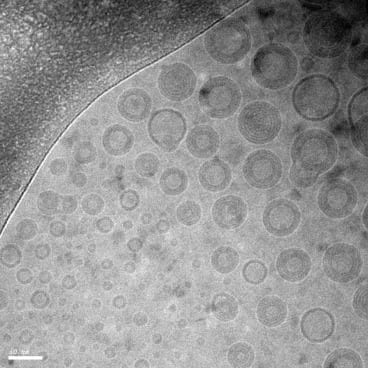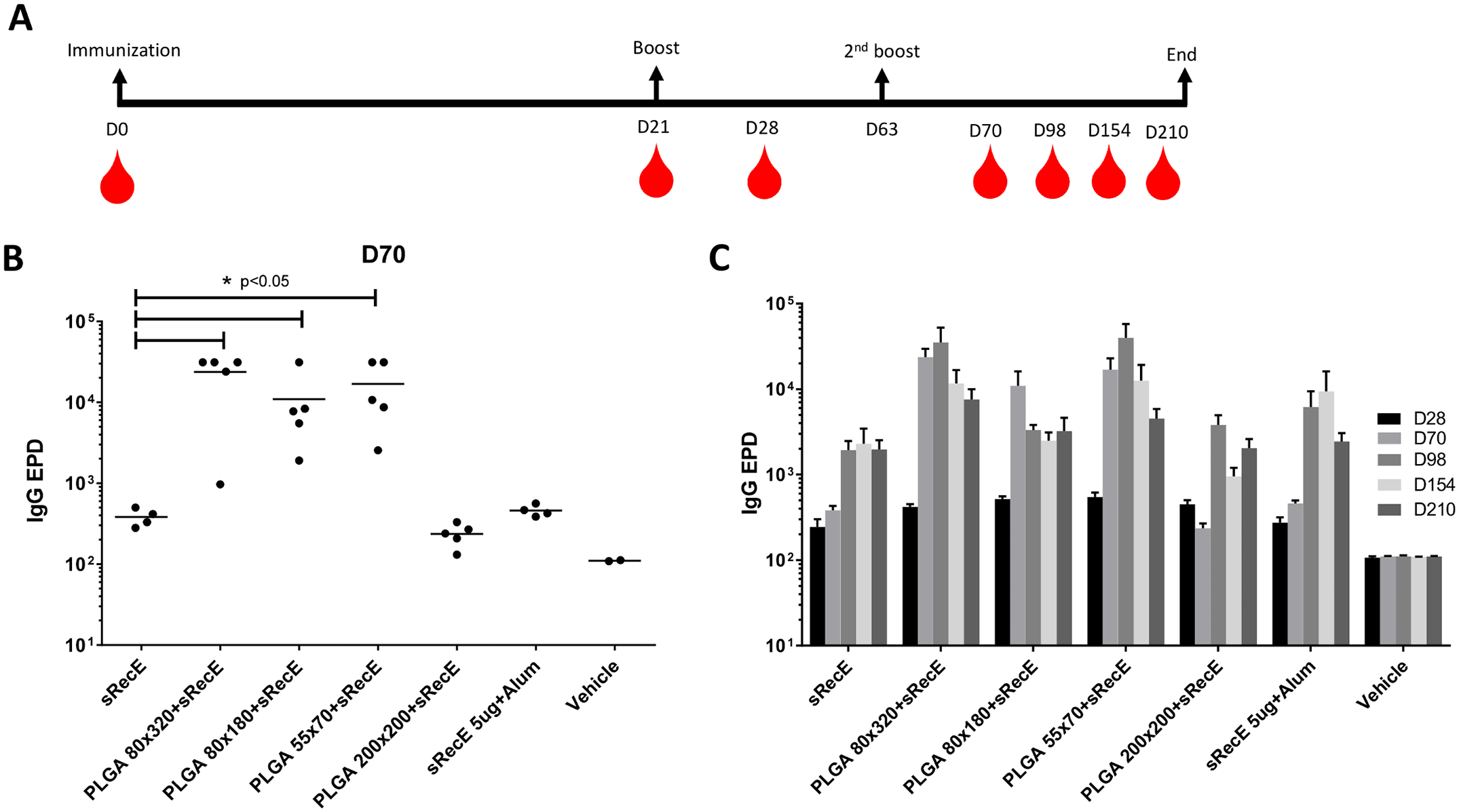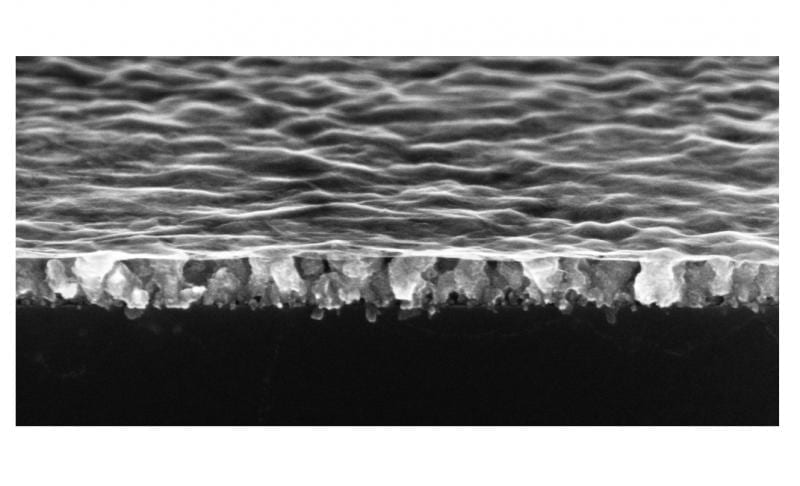
Particles that deliver vaccines directly to mucosal surfaces could defend against many infectious diseases.
Many viruses and bacteria infect humans through mucosal surfaces, such as those in the lungs, gastrointestinal tract and reproductive tract. To help fight these pathogens, scientists are working on vaccines that can establish a front line of defense at mucosal surfaces.
Vaccines can be delivered to the lungs via an aerosol spray, but the lungs often clear away the vaccine before it can provoke an immune response. To overcome that, MIT engineers have developed a new type of nanoparticle that protects the vaccine long enough to generate a strong immune response — not only in the lungs, but also in mucosal surfaces far from the vaccination site, such as the gastrointestinal and reproductive tracts.
Such vaccines could help protect against influenza and other respiratory viruses, or prevent sexually transmitted diseases such as HIV, herpes simplex virus and human papilloma virus, says Darrell Irvine, an MIT professor of materials science and engineering and biological engineering and the leader of the research team. He is also exploring use of the particles to deliver cancer vaccines.
“This is a good example of a project where the same technology can be applied in cancer and in infectious disease. It’s a platform technology to deliver a vaccine of interest,” says Irvine, who is a member of MIT’s Koch Institute for Integrative Cancer Research and the Ragon Institute of Massachusetts General Hospital, MIT and Harvard University.
Irvine and colleagues describe the nanoparticle vaccine in the Sept. 25 issue of Science Translational Medicine. Lead authors of the paper are recent PhD recipient Adrienne Li and former MIT postdoc James Moon.
Sturdier vaccines
Only a handful of mucosal vaccines have been approved for human use; the best-known example is the Sabin polio vaccine, which is given orally and absorbed in the digestive tract. There is also a flu vaccine delivered by nasal spray, and mucosal vaccines against cholera, rotavirus and typhoid fever.
To create better ways of delivering such vaccines, Irvine and his colleagues built upon a nanoparticle they developed two years ago. The protein fragments that make up the vaccine are encased in a sphere made of several layers of lipids that are chemically “stapled” to one another, making the particles more durable inside the body.
“It’s like going from a soap bubble to a rubber tire. You have something that’s chemically much more resistant to disassembly,” Irvine says.
This allows the particles to resist disintegration once they reach the lungs. With this sturdier packaging, the protein vaccine remains in the lungs long enough for immune cells lining the surface of the lungs to grab them and deliver them to T cells. Activating T cells is a critical step for the immune system to form a memory of the vaccine particles so it will be primed to respond again during an infection.
Stopping the spread of infection
In studies of mice, the researchers found that HIV or cancer antigens encapsulated in nanoparticles were taken up by immune cells much more successfully than vaccine delivered to the lungs or under the skin without being trapped in nanoparticles.
HIV does not infect mice, so to test the immune response generated by the vaccines, the researchers infected the mice with a version of the vaccinia virus that was engineered to produce the HIV protein delivered by the vaccine.
Mice vaccinated with nanoparticles were able to quickly contain the virus and prevent it from escaping the lungs. Vaccinia virus usually spreads to the ovaries soon after infection, but the researchers found that the vaccinia virus in the ovaries of mice vaccinated with nanoparticles was undetectable, while substantial viral concentrations were found in mice that received other forms of the vaccine.
Mice that received the nanoparticle vaccine lost a small amount of weight after infection but then fully recovered, whereas the viral challenge was 100 percent lethal to mice who received the non-nanoparticle vaccine.
“Giving the vaccine at the mucosal surface in the nanocapsule form allowed us to completely block that systemic infection,” Irvine says.
The Latest Bing News on:
Nanoparticle vaccine
- Our New Vaccine Could Protect Against Coronaviruses That Haven't Even Emerged Yet - New Study [analysis]on May 7, 2024 at 11:10 pm
The rapid development of vaccines that protect against COVID was a remarkable scientific achievement that saved millions of lives. The vaccines have demonstrated substantial success in reducing death ...
- New Vaccine Development Could Halt Future Pandemics, Study Suggests : ScienceAlerton May 7, 2024 at 7:55 pm
A groundbreaking scientific triumph was marked by the swift creation and distribution of vaccines to combat the COVID pandemic, ultimately saving millions of lives by significantly reducing the ...
- Our new vaccine could protect against coronaviruses that haven’t even emerged yet – new studyon May 7, 2024 at 7:53 am
The rapid development of vaccines that protect against COVID was a remarkable scientific achievement that saved millions of lives. The vaccines have demonstrated substantial success in reducing death ...
- Glioblastoma vaccine turns brain tumors from cold to hot in humans and dogson May 7, 2024 at 2:29 am
A personalized mRNA-based cancer vaccine for glioblastoma with an “onion-like” delivery mechanism can prolong survival both in dogs and humans, the results of a small study have suggested.
- Researchers develop a nanoparticle that can penetrate the blood-brain barrieron May 6, 2024 at 12:00 pm
Researchers at Sylvester Comprehensive Cancer Center at the University of Miami Miller School of Medicine have developed a nanoparticle that can penetrate the blood-brain barrier. Their goal is to ...
- Research aims to develop vaccine against future COVID viruseson May 6, 2024 at 7:48 am
Scientists are busy working on a vaccine that might fight strains of the COVID virus SARS-CoV-2 that haven't even emerged yet.
- 'Quartet Nanocage' vaccine found effective against coronaviruses that haven't even emerged yeton May 6, 2024 at 6:38 am
Researchers have developed a new vaccine technology that has been shown in mice to provide protection against a broad range of coronaviruses with potential for future disease outbreaks—including ones ...
- New vaccine effective against future coronaviruseson May 6, 2024 at 4:57 am
A new jab is effective against coronaviruses that haven’t even emerged yet, claim scientists. Cambridge University researchers have developed new vaccine technology that has been shown in mice to ...
- New vaccine effective against coronaviruses that haven’t even emerged yeton May 6, 2024 at 2:01 am
The new ‘Quartet Nanocage’ vaccine is based on a structure called a nanoparticle – a ball of proteins held together by incredibly strong interactions. Chains of different viral antigens are attached ...
- New mRNA Vaccines in Development for Cancer and Infectionson May 2, 2024 at 2:22 am
Prelog also discussed personalized vaccines for cancer immunotherapy. Personalized mRNA vaccines are tailored to the patient's genetic characteristics and antigens. They could be used in cancer ...
The Latest Google Headlines on:
Nanoparticle vaccine
[google_news title=”” keyword=”Nanoparticle vaccine” num_posts=”10″ blurb_length=”0″ show_thumb=”left”]
The Latest Bing News on:
Mucosal vaccines
- Everest Medicines Announces New Drug Application Approval of VELSIPITY® for Adults with Moderately to Severely Active Ulcerative Colitis in Macauon May 7, 2024 at 5:05 pm
Everest Medicines (HKEX 1952.HK, "Everest", or the "Company"), a biopharmaceutical company focused on the discovery, development, manufacturing and commercialization of innovative medicines and ...
- Cold and Flu Newson May 5, 2024 at 5:00 pm
Mar. 26, 2024 — Simply asking patients to get the flu vaccine, and combining it with helpful video and print messages, is enough to persuade many who visit emergency departments to roll up their ...
- Vaccine Adjuvants Market Size to Surpass USD 1.5 Billion by 2032, Exhibiting a CAGR of 4%on May 3, 2024 at 9:59 am
Allied Market Research published a report, titled, “Vaccine Adjuvants Market by Product Type (Immunostimulants and Vehicles & Mucosal Adjuvants), Disease (Infectious Diseases and Cancer), and ...
- Oral Vaccine Delivery: Can it Protect Against Non-mucosal Pathogens?on May 1, 2024 at 5:00 pm
The possibility of developing oral vaccines against non-mucosal pathogens is supported by studies with Japanese encephalitis and hepatitis B, which are transmitted by mosquito- and blood-borne ...
- Influenza Newson May 1, 2024 at 5:00 pm
Study of 800,000 pediatrician visits leverages links ... Feb. 26, 2024 — A research team has developed a recombinant protein flu vaccine candidate. It utilizes a nanoliposome vaccine platform ...
- Vaccine Developers Leverage mRNA and Other Powerful Technologieson April 30, 2024 at 5:00 pm
attenuated virus design with codon deoptimization to develop synthetic biology–based vaccine solutions. Using live, attenuated viruses can be advantageous against respiratory infections, facilitating ...
- Study rethinks immune system strategies to boost vaccine effectivenesson April 28, 2024 at 9:52 pm
A recent Cell journal review explores key immunological assumptions to enhance our understanding of vaccine design, autoimmune responses, and immune system pathology, aiming to refine intervention ...
- Oral Vaccine Delivery: Can it Protect Against Non-mucosal Pathogens?on April 27, 2024 at 5:00 pm
[1] All of these oral vaccines are designed to prevent diseases contracted through mucosal surfaces and are composed of either live-attenuated viruses/bacteria or killed whole cells. By contrast ...
- New UTI vaccine wards off infection for years, early studies suggeston April 26, 2024 at 12:39 pm
More than 50% of the patients who used a new mouth-spray-based vaccine didn't have a UTI for up to nine years.
- New UTI vaccine wards off infection for years, early studies suggeston April 25, 2024 at 5:00 pm
The vaccine is sprayed under the tongue because exposing the base of the tongue, the tonsils and the roof of the mouth is thought to trigger a strong immune response in "mucosal" tissues.
The Latest Google Headlines on:
Mucosal vaccines
[google_news title=”” keyword=”mucosal vaccines” num_posts=”10″ blurb_length=”0″ show_thumb=”left”]










